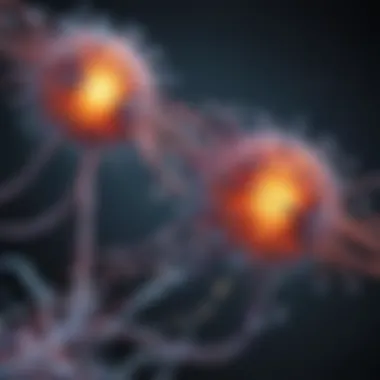Understanding Plasma Protein Binding in Pharmacology


Intro
Plasma protein binding is a crucial aspect of pharmacology and toxicology. It plays a significant role in the distribution, efficacy, and safety of drugs in the human body. Understanding the dynamics of plasma protein binding can provide valuable insights into drug action, making it an essential topic for researchers and healthcare professionals alike. This article delves into the mechanisms and implications of plasma protein binding, highlighting its importance in drug design and therapy.
Background and Context
Overview of the Research Topic
Plasma proteins, primarily albumin and alpha-1 acid glycoprotein, bind to various drugs. This binding can influence the free concentration of a drug in the bloodstream, ultimately affecting its therapeutic effects. When drugs are bound to plasma proteins, they are typically in a biologically inactive form. Only the unbound drug is available to exert pharmacological effects. Thus, changes in plasma protein binding can significantly alter drug efficacy and safety.
Historical Significance
The study of plasma protein binding has evolved over the years. Initially, pharmacologists viewed drug actions solely on free drug concentrations. However, the understanding of protein binding's role emerged with advances in pharmacokinetics. Researchers began to notice that variations in plasma protein levels could affect drug behavior, particularly in populations with diverse health conditions. This understanding paved the way for better therapeutic strategies and personalized medicine approaches.
Key Findings and Discussion
Major Results of the Study
Research underscores that plasma protein binding is influenced by multiple factors, including the chemical properties of the drug, the physiological state of the patient, and concurrent diseases. It has been found that:
- Drug characteristics: Lipophilicity and molecular weight influence how a drug interacts with proteins.
- Patient condition: Conditions such as liver or kidney disease can alter protein levels and thus impact binding capacity.
- Drug-drug interactions: Concurrent administration of multiple drugs can lead to competitive binding, altering the pharmacokinetics of the involved substances.
Detailed Analysis of Findings
The significance of plasma protein binding extends beyond simple binding affinities. It has implications for dosing regimens, potential toxicity, and therapeutic monitoring. For instance, understanding altered plasma protein binding in states like pregnancy, where total protein levels may change, can guide dose adjustments. Moreover, drugs with high protein binding may require careful monitoring to avoid adverse effects associated with sudden changes in binding due to factors like injury or surgery.
"Plasma protein binding serves as a double-edged sword; it protects drugs from rapid clearance but can also mask their therapeutic potential."
In clinical practice, evaluating plasma protein binding can enhance the understanding of pharmacokinetics and pharmacodynamics. This knowledge aids in optimizing drug therapy, especially for high-risk populations such as the elderly or those with chronic diseases.
Through understanding plasma protein binding, healthcare professionals can better predict how a drug will perform in the body. This understanding not only influences therapeutic effectiveness but also contributes to the overall safety of drug management.
Prologue to Plasma Protein Binding
Plasma protein binding is a fundamental concept in pharmacology that significantly affects how drugs are distributed and their overall therapeutic effectiveness. Understanding this topic is vital for optimizing drug therapies and improving patient outcomes. As drugs enter the bloodstream, they interact with various plasma proteins, which can restrict or facilitate their availability for action at cellular sites. The extent of binding can dictate therapeutic efficacy and safety, impacting treatment decisions.
In this section, we will delve into the definitions and classifications of plasma proteins. We will cover key aspects of plasma proteins important for understanding their binding characteristics. This comprehension is necessary for both researchers and practitioners, who must navigate complex interactions in drug administration and effects.
Defining Plasma Proteins
Plasma proteins are large biomolecules found in the blood plasma. They serve various functions, including maintenance of oncotic pressure, transport of nutrients and hormones, and involvement in immune responses. These proteins can be broadly categorized into several types, each with distinct roles and properties. Knowing what plasma proteins are is the starting point for understanding their binding behavior and implications for drug pharmacokinetics.
Types of Plasma Proteins
- Albumin: Albumin is the most abundant plasma protein, constituting about 60% of the total protein in the blood. Its primary role is to maintain osmotic pressure and act as a carrier for various substances, including fatty acids, hormones, and medications. Due to its high abundance and favorable binding characteristics, albumin is often a crucial point of reference in studies of plasma protein binding. Its large binding capacity can influence the free concentration of drugs, which is essential for their action.
- Alpha-1 Acid Glycoprotein: This protein is another significant plasma protein, albeit less abundant than albumin. Alpha-1 acid glycoprotein has a role in binding basic drugs and is important in cases of inflammation. Its concentration can increase significantly due to acute phase responses, thereby altering the binding profile of medications. Understanding alpha-1 acid glycoprotein is key when considering the pharmacokinetics of various drug therapies.
- Lipoproteins: Lipoproteins are complex particles that transport lipids through the bloodstream. They are not just to carry fats but also play a role in the binding and distribution of certain drugs, particularly those that are lipophilic. The influence of lipoproteins on drug binding can be critical for understanding the pharmacokinetic behavior of lipophilic medicines, driving certain therapeutic strategies and considerations.
In summary, the binding characteristics of plasma proteins like albumin, alpha-1 acid glycoprotein, and lipoproteins play a substantial role in defining therapeutic outcomes of drugs, making their understanding essential in pharmacology.
Mechanisms of Plasma Protein Binding
Understanding the mechanisms of plasma protein binding is crucial for comprehending how drugs and other substances interact within the body. Plasma proteins, primarily albumin, are responsible for the transport and distribution of many therapeutic agents. The binding of drugs to these proteins influences both the efficacy and safety of pharmacological treatments. As such, recognizing these mechanisms allows for better predictions of drug behavior, improves therapeutic outcomes, and aids in addressing various clinical challenges.
Binding Interactions
Binding interactions between plasma proteins and drugs are predominantly influenced by three main forces: electrostatic interactions, hydrophobic interactions, and van der Waals forces. Each of these interactions contributes uniquely to the binding affinity and specificity.
Electrostatic Interactions
Electrostatic interactions occur due to the attraction or repulsion between charged entities. In the context of plasma protein binding, this dynamic is significant. Drugs that carry a charge can interact with oppositely charged regions on plasma proteins, leading to strong binding. The key characteristic of electrostatic interactions is their dependence on environmental factors such as pH and ionic strength. This makes them a popular mechanism in drug binding, as variations in bodily fluids can influence drug performance. However, while advantageous due to their strength, these interactions can also be problematic. Changes in plasma conditions can alter binding characteristics, potentially impacting drug levels in the blood.
Hydrophobic Interactions
Hydrophobic interactions are driven by the aversion of nonpolar substances to water. In plasma protein binding, drugs often possess hydrophobic regions that interact favorably with the hydrophobic pockets of proteins. The primary advantage of these interactions is their relative stability in physiological conditions. Hydrophobic interactions are a common choice in this article as they play a significant role in determining drug distribution and tissue permeability. Nonetheless, the unique feature of hydrophobic interactions lies in their weaker binding strength compared to electrostatic forces. This may lead to a less predictable drug-distribution profile, impacting overall therapeutic efficacy.


Van der Waals Forces
Van der Waals forces are weak attractions that occur between molecules or parts of molecules due to transient local partial charges. In plasma protein binding, these forces provide additional stabilization to the drug-protein complex. Their key characteristic is that they can contribute to binding even at larger distances, which may help stabilize the drug within the plasma environment. This makes them beneficial in the context of maintaining drug presence in circulation. However, the disadvantage of reliance on van der Waals forces is that they are not a primary driver for the binding process, meaning they typically supplement stronger interactions like electrostatic and hydrophobic forces.
Free Drug Concentration
The concentration of unbound or free drug in the plasma is a critical parameter in pharmacokinetics. It is this free drug that actively exerts therapeutic effects. Therefore, understanding the dynamics of plasma protein binding can provide insights into drug action and efficacy. A drug that is highly bound may have a lower free concentration, potentially reducing its effectiveness. As plasma protein binding can vary due to numerous factors like age, disease state, and drug properties, monitoring free drug concentrations can markedly enhance therapeutic interventions and personalizes treatment strategies.
Factors Affecting Plasma Protein Binding
Plasma protein binding is not a uniform process. Various factors influence how drugs interact with plasma proteins, impacting their distribution and efficacy. Understanding these factors is essential for optimizing drug therapy and managing therapeutic outcomes in diverse populations. They are divided into physiological factors and chemical properties of the drugs.
Physiological Factors
Physiological factors include age, gender, and pathophysiological conditions. Each of these elements plays a vital role in how plasma proteins bind with drugs. Changing these factors can lead to variations in plasma protein levels, which in turn affects how drugs work in different people.
Age
As people age, their body composition and physiological functions change. This is significant in the context of plasma protein binding. Older individuals may have altered liver and kidney functions, which can impact the production and elimination of plasma proteins. The decrease in total body water and lean mass in the elderly compared to younger individuals may also affect the volume of distribution for hydrophilic drugs, resulting in higher concentrations available for binding.
A key characteristic of age is its influence on homeostasis. Aging can lead to conditions such as malnourishment or chronic diseases, further compromising protein levels. An older adult may have a higher free drug concentration, thereby increasing the potential for drug activity or toxicity. The unique feature of age's impact lies in its multifactorial nature, with advantages and disadvantages that vary depending on the drug and health condition.
Gender
Gender differences can affect plasma protein binding due to hormonal influences and body composition variations. Men and women often have different levels of specific plasma proteins. For example, albumin is generally higher in men, while alpha-1 acid glycoprotein is more prevalent in women, especially during pregnancy.
This difference in protein levels leads to variability in drug response. A key characteristic of gender is the impact on drug metabolism and excretion. Women may process certain drugs differently, which is important in clinical considerations. For instance, a drug with high affinity for a protein predominantly found in one gender might result in different therapeutic needs and outcomes.
Pathophysiological Conditions
Pathophysiological conditions such as liver disease, kidney disease, and malnutrition can significantly alter plasma protein binding profiles. These conditions affect protein synthesis, metabolism, and clearance of drugs from the body. The binding of drugs can be reduced, leading to increased free drug concentrations in the system.
A key characteristic of these conditions is how they disrupt normal physiological processes. For example, liver dysfunction can lead to decreased albumin production, causing a higher free drug fraction. Malnutrition may also lead to lower levels of plasma proteins. This unique feature emphasizes the importance of tailoring therapy based on an individual's health status to avoid adverse effects and improve efficacy.
Chemical Properties of Drugs
Chemical properties of drugs also play a significant role in plasma protein binding. Factors like molecular weight, polarity, and acidity/basicity determine how effectively a drug will bind to plasma proteins and how it will act in the body. Understanding these can lead to improved drug design and therapeutic strategies.
Molecular Weight
Molecular weight of a drug is critical in determining its ability to bind to plasma proteins. Generally, larger molecules have a stronger binding affinity due to increased surface area for interactions. However, they may also have more complex kinetics in distribution.
A key characteristic of molecular weight is its correlation to excretion. High molecular weight drugs often get excreted slower, leading to prolonged circulation time and increased binding. This can enhance drug efficacy but may also lead to toxicity if not monitored well. Hence, it sits in a delicate balance between effectiveness and safety.
Polarity
Polarity affects the solubility and distribution of drugs and plays an integral role in plasma protein binding. Lipophilic (non-polar) drugs tend to bind more effectively to lipoproteins, while hydrophilic (polar) drugs generally have a higher free fraction since they have less affinity for proteins.
A key characteristic is the influence on tissue distribution. Lipophilic drugs often accumulate in fatty tissues, altering their pharmacokinetic profiles. Understanding the polarity of a drug is beneficial for predicting how it behaves in the body and adjusting dosage accordingly. However, there can be disadvantages if the drug’s properties lead to unintended accumulation in tissues, risking side effects.
Acidity and Basicity
The acidity and basicity of a drug play significant roles in its plasma protein binding and overall pharmacokinetics. The ionization state of a drug at physiological pH influences its ability to cross membranes and interact with plasma proteins. Acidic drugs may bind differently than basic drugs due to their charge and solubility.
A key characteristic is how variations in pH, which often occur in pathological conditions, can influence drug efficacy. This helps assess how drugs can be absorbed and distributed in the body. The benefit of understanding these properties lies in designing drugs that can either maximize binding or reduce possible side effects due to altered bioavailability.
Measuring Plasma Protein Binding
Measuring plasma protein binding is an essential part of pharmacokinetics and drug development. The significance of understanding how drugs bind to plasma proteins cannot be overstated. It affects the distribution, efficacy, and safety of therapeutic compounds. By quantifying binding, researchers can gain insights into drug behavior in the body, leading to more effective and safer medications. This section explores various techniques for assessment and the interpretation of binding data.
Techniques for Assessment
Equilibrium Dialysis
Equilibrium dialysis is a widely used method for assessing plasma protein binding. This technique utilizes a semi-permeable membrane that separates the plasma from a buffer solution. Drug molecules can pass through this membrane based on their binding affinity.


A key characteristic of equilibrium dialysis is its simplicity and reliability. It allows for the measurement of free and bound drug concentrations accurately. The unique feature of this method is its ability to mimic physiological conditions, making the data more relevant for in vivo assessments.
Advantages of equilibrium dialysis include its reproducibility and minimal interference from other components. However, this method can be time-consuming, and factors like protein concentration and drug properties can influence the results.
Ultrafiltration
Ultrafiltration is another valuable technique for measuring plasma protein binding. This method employs a filter that allows free drug molecules to pass while retaining the bound fraction. By analyzing the concentration of the free drug, researchers can infer the extent of binding.
The key characteristic of ultrafiltration is its efficiency. It is often quicker than equilibrium dialysis, offering faster results for binding studies. A significant advantage is the capability to handle samples with complex matrices, which makes it suitable for various experimental conditions.
On the downside, ultrafiltration may require careful optimization of filter parameters to ensure accurate measurements. Membrane properties can also affect the results, requiring thorough validation for each specific application.
Affinity Chromatography
Affinity chromatography is a sophisticated method for assessing plasma protein binding, employing a stationary phase with specific ligands that selectively interact with the drug. This technique often provides detailed insights into binding kinetics and affinity, making it a powerful tool in drug development.
The key characteristic of affinity chromatography is its specificity. It can provide information on how different factors influence binding interactions, leading to a comprehensive understanding of the drug's behavior. The unique feature of this method is its flexibility, allowing adjustments for different compounds and binding targets.
However, the disadvantages include the complexity and the necessity for specialized equipment and expertise. Moreover, it may not be as high-throughput as other techniques, potentially limiting its application in some screening settings.
Interpreting Binding Data
Interpreting binding data requires careful analysis of results obtained from the above techniques. The free fraction of a drug in plasma is critical for understanding its pharmacological activity. Various factors, such as molecular properties and physiological conditions, can affect binding interpretations. Clear understanding of these elements enhances the ability to make informed decisions regarding drug dosing and efficacy.
Clinical Implications of Plasma Protein Binding
Understanding plasma protein binding is crucial in the field of pharmacology. It has direct implications on drug efficacy, therapeutic outcomes, and drug interactions. Recognizing these factors can significantly enhance the safety and effectiveness of treatment strategies.
Impact on Drug Efficacy
The binding of drugs to plasma proteins influences their pharmacokinetic profile. When a drug binds to plasma proteins, only the unbound fraction is pharmacologically active. This implies that the concentration of the free drug available at the target sites determines its therapeutic effect.
- Bioavailability: The extent of a drug's effect is often reliant on how much of it is circulating freely in the bloodstream. High protein binding can lead to a decrease in bioavailability, meaning that the body has less of the active form of the drug to rely on.
- Dosing Considerations: Clinicians must consider the plasma protein binding characteristics when determining dosing regimens. For instance, drugs that have high protein binding may require higher doses to achieve adequate therapeutic levels. Conversely, in situations where the protein binding decreases, such as in liver disease, standard doses may lead to toxicity because of increased free drug concentrations.
"The relationship between protein binding and drug efficacy is invaluable in developing safe and effective therapeutic regimens."
Drug-Drug Interactions
Plasma protein binding also has implications in drug-drug interactions. When multiple drugs are administered simultaneously, they can compete for binding sites on plasma proteins. This competition can lead to alterations in the free concentrations of the drugs involved.
- Increased Risks of Toxicity: If one drug displaces another from its binding site, this can increase the free concentration of the displaced drug, possibly leading to toxicity.
- Therapeutic Failures: Conversely, if a drug that is crucial for treatment is displaced, its efficacy may be compromised, leading to therapeutic failures.
- Monitoring and Adjustment: It is important for healthcare providers to monitor patients on multiple medications closely. Adjustments may be necessary based on how drugs are interacting with plasma proteins.
In summary, understanding the clinical implications of plasma protein binding is critical for optimizing drug therapy. The effects on drug efficacy and potential for drug-drug interactions should not be underestimated, as they play a significant role in patient management and treatment outcomes.
Plasma Protein Binding in Disease States
Plasma protein binding plays a notable role in how drugs are processed in the body. Changes in plasma protein levels can lead to significant variations in drug efficacy and safety in patients with various disease states. Understanding these alterations is necessary to optimize therapeutic approaches. This section delves into how specific conditions, such as liver disease, kidney disease, and malnutrition, affect plasma protein binding, ultimately impacting medication management and therapeutic outcomes.
Alterations in Binding Profiles
Liver Disease
Liver disease exemplifies a critical factor influencing plasma protein binding due to its effect on the synthesis of proteins like albumin. Albumin is a primary blood protein responsible for binding many drugs. In liver disease, reduced albumin levels occur, leading to an increased free fraction of drugs in circulation. This situation is significant as it can enhance drug activity and the risk of toxicity. Additionally, conditions such as cirrhosis complicate the pharmacokinetics by altering the drug's volume of distribution. The unique feature here is the liver's dual role; it not only produces binding proteins but also modifies drug metabolism, creating a complex interaction affecting treatment efficacy.
Kidney Disease
Kidney disease also significantly impacts plasma protein binding through alterations in protein levels and kidney function. In such cases, the kidney's capability to filter and excrete drugs demonstrates a need for close monitoring. Many drugs rely on renal clearance, and when kidney function decreases, the protein binding changes, resulting in greater free drug concentrations. This unique aspect emphasizes the importance of dose adjustments in patients with kidney impairment. If not monitored, it poses a risk of overdosing.
Malnutrition
Malnutrition affects various aspects of health, including plasma protein levels. In nutritional deficiencies, there is often a decrease in total protein levels, especially albumin. This reduction can alter the dynamics of drug binding, leading to an increase in the free drug concentration, similar to the scenarios presented in liver and kidney disease. The unique feature regarding malnutrition is its broader influence on multiple physiological systems and not solely on plasma protein levels. Consideration of malnutrition is vital when managing therapies, as it can compromise drug efficacy by increasing the potential for side effects.
Therapeutic Monitoring Adjustments
Monitoring drug levels and adjusting therapies based on plasma protein binding alterations during these diseases are crucial. It ensures not only the effectiveness of treatment but also minimizes the likelihood of adverse effects. Regular assessments allow healthcare providers to tailor dosages appropriately, considering the patient's current metabolic state. This attention can lead to improved patient outcomes and enhance the overall success of pharmacotherapy.


Role of Plasma Protein Binding in Drug Development
Plasma protein binding significantly affects the pharmacokinetics of drugs, making it a critical consideration in drug development. Understanding this binding can influence everything from drug formulation to efficacy. This awareness can lead to better therapeutic outcomes and minimize adverse effects.
Considerations in Formulation
When developing a new drug, formulation scientists must assess how the drug interacts with plasma proteins. The degree of binding affects the drug's solubility, stability, and release characteristics. Key considerations include:
- Solubility: Drugs that bind strongly to plasma proteins may have lower solubility in blood, altering how they are absorbed and distributed in the body.
- Stability: Plasma protein binding can influence the stability of the drug, impacting its shelf-life and effectiveness over time.
- Release Profiles: Understanding binding interactions is crucial for creating controlled-release formulations that maintain effective drug concentrations over time.
Optimizing these factors helps ensure that the drug reaches its target site effectively while minimizing side effects.
Predicting In Vivo Outcomes
The relationship between plasma protein binding and in vivo drug behavior is complex. For drug developers, predicting how a drug will perform in the body is essential.
- Dosing Strategies: Accurate knowledge of plasma protein binding informs dosing regimens. A drug that is highly bound may require higher doses to achieve therapeutic levels in plasma.
- Variability in Response: Individual patient characteristics, including age, weight and disease state, can affect plasma protein levels and thus impact drug efficacy. Researchers must consider these factors when designing clinical trials.
- Risk of Drug Interactions: High plasma protein binding can result in significant drug-drug interactions. This risk must be evaluated to prevent potential therapeutic failures or toxicities.
The understanding of plasma protein binding is essential in drug development. It determines not only the drug's action but also its safety profile and effective use in treatment.
In summary, focusing on plasma protein binding during drug development enhances the ability to predict and optimize drug performance in clinical settings. Addressing these considerations can lead to more effective and safer therapeutic options.
Emerging Research in Plasma Protein Binding
Emerging research in plasma protein binding is vital for advancing our understanding of pharmacology and drug development. This area focuses on new mechanisms and indicators that significantly affect therapeutic outcomes. As new drugs are developed, distinguishing binding profiles can lead to improved efficacy and reduced toxicity. Therefore, ongoing investigation in this field is essential for enhancing drug design and individualized treatment plans.
Novel Binding Mechanisms
Recent studies have introduced innovative binding mechanisms that challenge traditional paradigms. These mechanisms represent specific interactions between drugs and plasma proteins that were not fully understood before. By understanding such interactions, pharmaceutical scientists can tailor compounds to optimize their pharmacokinetic profiles. This tailoring can result in drugs that have higher bioavailability and longer half-lives, significantly impacting treatment regimens.
The focus on novel binding mechanisms also encompasses alternative binding sites on proteins. Findings suggest that certain drugs can bind not just to albumin, but also to alternative sites that may alter therapeutic effects and safety profiles. Researchers are investigating these binding sites extensively, as they could provide new insights into drug action and potential side effects.
It is crucial to identify these novel bindings during the drug development process. Emerging research utilizes advanced technologies, such as nuclear magnetic resonance spectroscopy and mass spectrometry, to visualize bindings and interactions at the molecular level.
Biomarkers for Binding Assessment
The exploration of biomarkers for binding assessment has substantial implications in clinical pharmacology. Biomarkers can serve as indicators of plasma protein binding status, providing valuable insights into drug behavior in vivo. This enables clinicians to make informed decisions regarding drug selection and dosing strategies.
Recent advancements have paved the way to identify specific biomarkers that correlate with plasma protein binding. These biomarkers can help predict individual responses to medications based on unique protein profiles. For instance, variations in albumin levels due to disease states can directly affect drug efficacy. Identifying these biomarkers allows for more personalized medicine approaches, improving patient outcomes remarkably.
In summary, the emergence of novel binding mechanisms and biomarkers for binding assessment represent significant advances in the field of plasma protein binding. Such advancements can lead to improved drug properties and individualized treatments. These research pathways carry the potential to reshape treatment paradigms in pharmacology, ensuring that patients receive more effective and safer therapies.
Epilogue
The discussion around plasma protein binding is crucial in understanding pharmacology and its associated applications. In the context of this article, the conclusion serves as a synthesis of the multifaceted elements discussed. Recognizing the complexity of plasma protein binding helps illuminate its significant roles in drug efficacy, distribution, and safety.
Key benefits of grasping this topic include informed drug development and optimized therapy regimens. It enhances insight into how alterations in protein binding can impact drug availability and effects in various patient populations.
Moreover, considering specific physiological conditions or individual variations can guide clinicians in adjusting therapeutic approaches. Practitioners who understand plasma protein binding are better prepared to anticipate potential drug interactions. This awareness ultimately aligns with improved patient outcomes, illustrating the practical implications of this topic in clinical and research settings.
Summary of Key Points
- Plasma protein binding influences drug distribution and efficacy.
- Various plasma proteins, such as albumin, play significant roles in the binding process.
- Different factors, including molecular weight and polarity, affect binding characteristics.
- Measurement techniques like equilibrium dialysis and ultrafiltration provide insight into binding profiles.
- Changes in binding may occur during disease states, requiring adjustments in therapeutic strategies.
- Understanding this topic is essential in drug development and optimizing safety and efficacy in treatment.
Understanding plasma protein binding is not merely an academic concept; it has direct implications for how drugs perform in the body.
Importance of References
References offer several key benefits:
- Validation of Information: Each claim regarding plasma protein binding mechanisms, implications, and clinical relevance is strengthened by citations from peer-reviewed journals or reputable sources. This lends authority to the article, ensuring that readers can trust the information provided.
- Expanded Learning: By providing a list of references, readers are given the opportunity to explore additional literature, which may cover experimental data, related theories, or advanced topics that were not fully explored in the main body of the article.
- Evidence of Research: The field related to plasma protein binding evolves continually. Citing current studies and reviews indicates that the content is not only relevant but grounded in up-to-date research, reflecting the dynamic nature of pharmacology and toxicology.
Considerations for Citing References
When compiling references, several considerations must be kept in mind:
- Relevance: Ensure that the sources are directly related to the topic of plasma protein binding. Irrelevant citations can confuse readers and dilute the potency of the arguments.
- Recency: Given the rapid advancements in pharmaceutical science, choosing more recent studies helps maintain the pertinence of the information. Older sources may lack the nuances required for understanding current practices.
- Diversity of Sources: It is advisable to include a variety of sources, such as clinical trials, systematic reviews, and basic scientific studies. This diversity adds depth to the discussion.
Concluding Remarks
To summarize, references are more than a list of works cited. They are the backbone of academic writing, enabling a dialogue with the broader scientific community. For topics like plasma protein binding, which play a pivotal role in pharmacokinetics, ensuring that the evidence is robust and well-supported through references significantly enhances the discourse.







